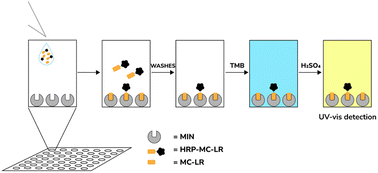Molecularly imprinted nanoparticle-based assay (MINA) for microcystin-LR detection in water†
Abstract
Microcystins (MCs) are highly toxic peptides produced by cyanobacteria during algal blooms. Microcystin-leucine-arginine (MC-LR) is the most toxic and common MC variant with major effects on human and animal health upon exposure. MC-LR detection has become critical to ensure water safety, therefore robust and reliable analytical methods are needed. This work reports the development of a simple and optimized Molecularly Imprinted Nanoparticle-Based Assay (MINA) for MC-LR detection in water. Molecularly Imprinted Nanoparticles (MINs) were prepared by solid-phase polymerization on glass beads conjugated to MC-LR through (3-aminopropyl) triethoxysilane (APTES) via amide bonding. APTES-modified glass beads were obtained under optimized conditions to maximize the density of surface amino groups available for MC-LR conjugation. Two quinary mixtures of acrylic monomers differing in charge, polarity, and functionality were selected from molecular docking calculations and used to obtain MINs for MC-LR recognition using N,N′-methylene-bis-acrylamide (BIS) as the crosslinking agent. MINs were immobilized by physical adsorption onto 96-well polystyrene microplate and evaluated as per their rebinding capacity toward the analyte by using a covalent conjugate between MC-LR and the enzyme horseradish peroxidase (HRP). Experimental conditions for the MINs immobilization protocol, HRP-MC-LR concentration, and composition of the blocking solution were set to maximize the colorimetric response of the MINs compared to non-treated wells. Optimized conditions were then applied to conduct competitive MINAs with the HRP-MC-LR conjugate and the free analyte, which confirmed the preferential binding of MC-LR to the immobilized MINs for analyte concentrations ranging from 1 × 10−5 nmol L−1 to 100 nmol L−1. The best competitive MINA showed a limit of detection of 2.49 × 10−4 nmol L−1 and coefficients of variation less than 10% (n = 6), which are auspicious for the use of MINs as analytical tools for MC-LR detection below the permissible limits issued by WHO for safe water consumption (1.00 nmol L−1). This assay also proved to be selective to the analyte in cross-reactivity studies with two analogous microcystins (MC-RR and MC-YR). Analyses of lagoon and drinking water samples enriched with MC-LR revealed strong matrix effects that reduce the MINA response to the analyte, thus suggesting the need for sample pretreatment methods in future development in this subject.

- This article is part of the themed collection: Celebrating Latin American Chemistry


 Please wait while we load your content...
Please wait while we load your content...